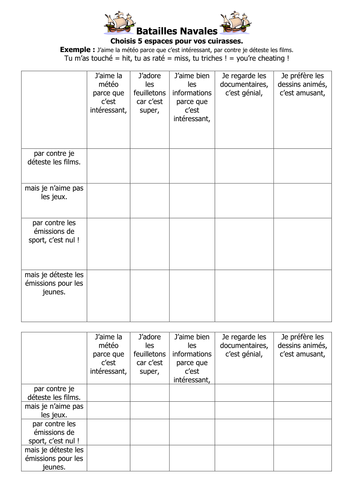

Expressions:
Un dessin animé.
Un jeu.
Une émission sportive.
Une émission pour les jeunes.
La météo.
Les informations.
Un documentaire.
Un film.
Un feuilleton.
The first slide encourages the students to actively engage with the new vocabulary: working in teams, using their prior knowledge, knowledge of other languages and using a process of elimination to figure out the meanings. They then discuss the pronunciation and question each other (QFQs = quick fire questions) before the teacher checks with the whole class.
The first slides have the phrase and a picture. Use this to elicit the pronunciation, the English and to drill. The next section of slides have multiple choice questions. The final slide has pictures of all the phrases where you can ask: Qu’est-ce que c’est?. This can also be used for a Beat the Teacher game, which the students love!
The teacher points to a picture and says a word. If it is the correct word the students all repeat it. If its the wrong word the students must stay absolutely silent. If they do, they win 1 point. If not, the teacher gets 1 point. Most points wins!
Battleships:
Expressions:
J’aime la météo parce que c’est intéressant,
J’adore les feuilletons car c’est super,
J’aime bien les informations parce que c’est intéressant,
Je regarde les documentaires, c’est génial,
Je préfère les dessins animés, c’est amusant,
par contre je déteste les films.
mais je n’aime pas les jeux.
par contre les émissions de sport, c’est nul !
mais je déteste les émissions pour les jeunes.
Battleships Game
Firstly I ask the students to work independently in pairs to translate the expressions.
The students then focus on pronunciation and decide the two easiest and two most difficult words to pronounce.
I then check the translations and drill pronunciation with the whole class before they play the game. The students secretly choose 5 squares on the top grid and then try to guess which 5 squares their partner has chosen, filling in the bottom grid with “hit” and “miss.” To choose a square say a phrase from the horizontal line and complete the sentence with a phrase from the vertical line. Where the 2 phrases meet up is the square you have chosen.
I use the English language sheet to further challenge the students: they should place this on top of the French version and then try to play the game saying the French phrases as far as possible from memory. I allow the really weak students to have the French version next to the English version so they have lots of support, stronger students are allowed a few “sneaky peaks” at the French version and the really strong students aim to refer back to the French version as little as possible.
Un dessin animé.
Un jeu.
Une émission sportive.
Une émission pour les jeunes.
La météo.
Les informations.
Un documentaire.
Un film.
Un feuilleton.
The first slide encourages the students to actively engage with the new vocabulary: working in teams, using their prior knowledge, knowledge of other languages and using a process of elimination to figure out the meanings. They then discuss the pronunciation and question each other (QFQs = quick fire questions) before the teacher checks with the whole class.
The first slides have the phrase and a picture. Use this to elicit the pronunciation, the English and to drill. The next section of slides have multiple choice questions. The final slide has pictures of all the phrases where you can ask: Qu’est-ce que c’est?. This can also be used for a Beat the Teacher game, which the students love!
The teacher points to a picture and says a word. If it is the correct word the students all repeat it. If its the wrong word the students must stay absolutely silent. If they do, they win 1 point. If not, the teacher gets 1 point. Most points wins!
Battleships:
Expressions:
J’aime la météo parce que c’est intéressant,
J’adore les feuilletons car c’est super,
J’aime bien les informations parce que c’est intéressant,
Je regarde les documentaires, c’est génial,
Je préfère les dessins animés, c’est amusant,
par contre je déteste les films.
mais je n’aime pas les jeux.
par contre les émissions de sport, c’est nul !
mais je déteste les émissions pour les jeunes.
Battleships Game
Firstly I ask the students to work independently in pairs to translate the expressions.
The students then focus on pronunciation and decide the two easiest and two most difficult words to pronounce.
I then check the translations and drill pronunciation with the whole class before they play the game. The students secretly choose 5 squares on the top grid and then try to guess which 5 squares their partner has chosen, filling in the bottom grid with “hit” and “miss.” To choose a square say a phrase from the horizontal line and complete the sentence with a phrase from the vertical line. Where the 2 phrases meet up is the square you have chosen.
I use the English language sheet to further challenge the students: they should place this on top of the French version and then try to play the game saying the French phrases as far as possible from memory. I allow the really weak students to have the French version next to the English version so they have lots of support, stronger students are allowed a few “sneaky peaks” at the French version and the really strong students aim to refer back to the French version as little as possible.
Something went wrong, please try again later.
This resource hasn't been reviewed yet
To ensure quality for our reviews, only customers who have purchased this resource can review it
Report this resourceto let us know if it violates our terms and conditions.
Our customer service team will review your report and will be in touch.
£3.00
